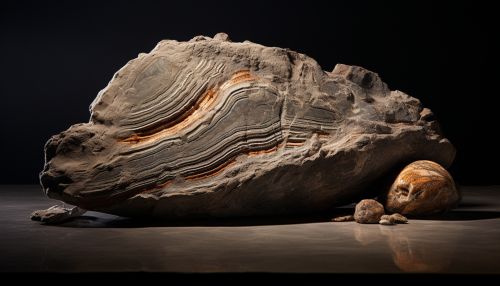Taphonomy and Fossil Preservation
Introduction
Taphonomy, derived from the Greek words "taphos" meaning burial, and "nomos" meaning law, is the study of the processes that occur in an organism's decay following its death, leading to its fossilization. This scientific discipline is an essential part of paleontology, as it provides insights into how organisms become part of the fossil record and the factors that influence fossil preservation. The study of taphonomy involves various sub-disciplines, including biology, geology, and chemistry, among others.


Taphonomic Processes
Taphonomic processes can be divided into two main categories: biostratinomic and diagenetic processes.
Biostratinomic Processes
Biostratinomic processes occur shortly after the death of an organism and before its burial. These processes include decomposition, disarticulation, transportation, and reorientation. Decomposition refers to the breakdown of organic matter by decomposers, such as bacteria and fungi. Disarticulation is the separation of an organism's parts, often due to scavenging or physical processes like water currents. Transportation refers to the movement of an organism or its parts from the place of death to the site of burial, while reorientation involves the change in the position of the organism or its parts due to external forces.
Diagenetic Processes
Diagenetic processes occur after the burial of an organism. These processes include compaction, mineralization, and dissolution. Compaction is the reduction in the volume of an organism or its parts due to the weight of overlying sediment. Mineralization, also known as fossilization, is the replacement of organic material with minerals, leading to the formation of a fossil. Dissolution is the removal of the original material of an organism, leaving a void or mold that can later be filled with minerals to form a cast.
Fossil Preservation
The preservation of fossils can vary greatly, from unaltered remains to trace fossils. The type of preservation often depends on the environment and the taphonomic processes that the organism underwent.
Unaltered Preservation
Unaltered preservation refers to fossils that retain their original material. This type of preservation is rare, as most organisms undergo decomposition and mineralization. Examples of unaltered preservation include amber-preserved insects and mammoths preserved in ice.
Permineralization
Permineralization is a common form of fossil preservation. In this process, the pores and cavities of an organism's hard parts, such as bones and shells, are filled with minerals from groundwater. The result is a fossil that retains the original structure of the organism but is much heavier and harder.
Replacement and Recrystallization
Replacement involves the substitution of the original material of an organism with a different mineral. For example, shell material can be replaced by silica, pyrite, or calcite. Recrystallization, on the other hand, involves the change in the crystal structure of the original mineral without changing its chemical composition. This process often results in the loss of fine details.
Carbonization
Carbonization occurs when an organism is subjected to heat and pressure, causing the volatile elements to be driven off, leaving behind a thin film of carbon. This process often preserves delicate structures, such as leaves and feathers.
Molds and Casts
Molds and casts form when the original material of an organism dissolves, leaving a void. If this void is filled with sediment or mineral-rich water, a cast can form. Molds and casts can preserve both external and internal structures of an organism.
Factors Influencing Fossil Preservation
Numerous factors can influence the preservation of fossils. These include the characteristics of the organism, the environment, and the timing of burial.
Organism Characteristics
The characteristics of an organism can greatly influence its potential for fossilization. Hard parts, such as bones, teeth, and shells, are more likely to fossilize than soft tissues. However, under certain conditions, soft tissues can also be preserved, as evidenced by the Burgess Shale and other exceptional fossil sites.
Environmental Factors
The environment plays a crucial role in fossil preservation. Aquatic environments, particularly deep-sea and low-oxygen environments, are conducive to fossil preservation due to rapid burial and reduced decomposition. Terrestrial environments, on the other hand, often lead to the destruction of remains due to weathering and scavenging.
Timing of Burial
The timing of burial can also influence fossil preservation. Rapid burial can protect remains from scavengers and weathering, increasing the chances of preservation. Conversely, slow burial can lead to the destruction of remains.
Conclusion
Taphonomy and fossil preservation are key aspects of paleontology, providing valuable insights into the life and death of ancient organisms. By studying these processes, scientists can reconstruct past ecosystems and understand the factors that influence the preservation of fossils. Despite the many challenges, the study of taphonomy continues to shed light on the history of life on Earth.
